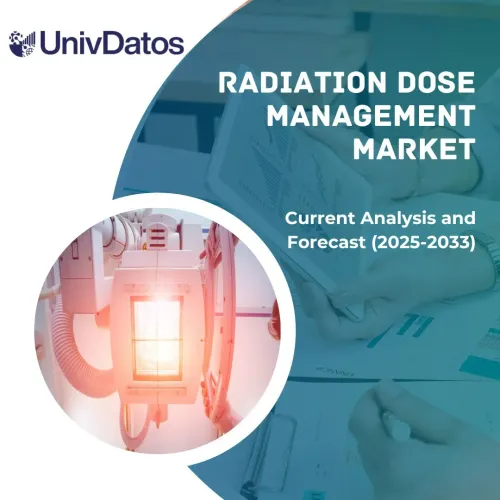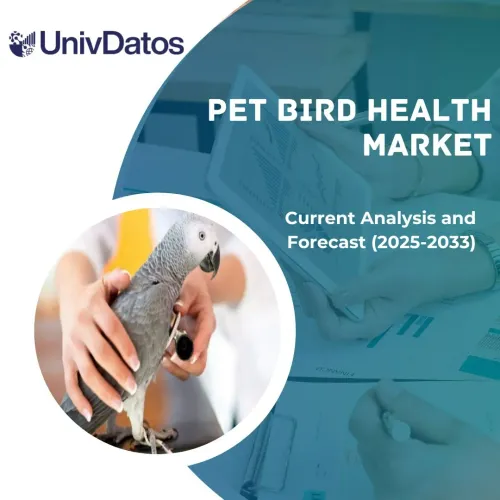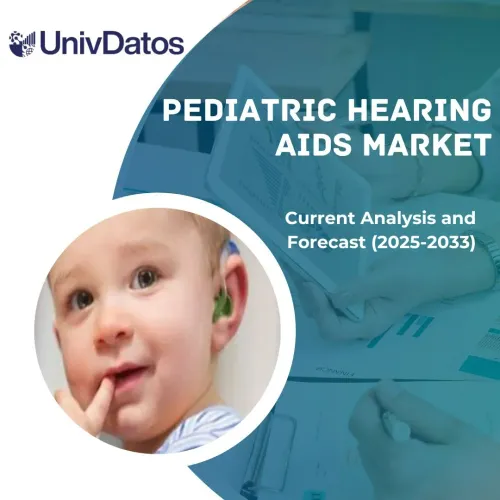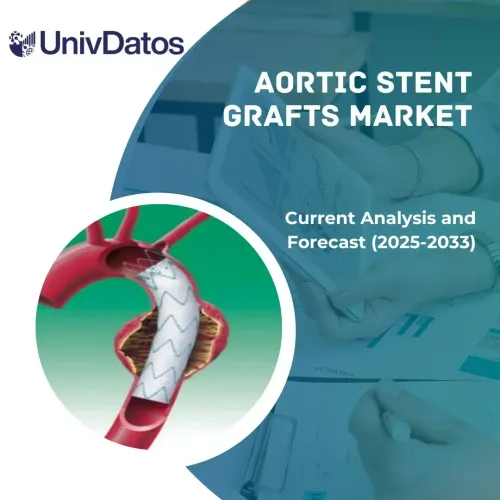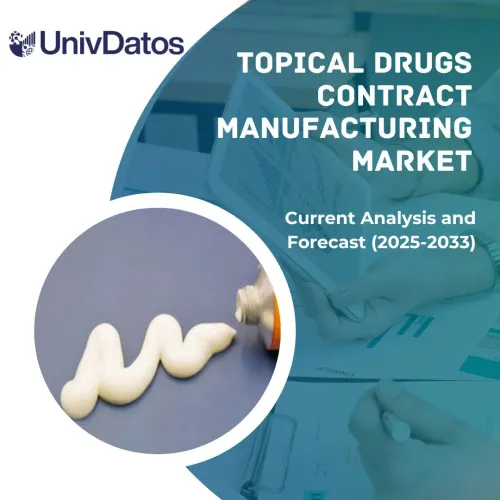- Home
- About Us
- Industry
- Services
- Reading
- Contact Us
Plasma Fractionation Market: Current Analysis and Forecast (2021-2027)
Product (Immunoglobulins, Coagulation Factor Concentrates, Albumin, Protease Inhibitors, Others); Application (Neurology, Immunology, Hematology, Critical care, Pulmonology, Others); End-User (Hospitals & Clinics, Clinical Research Laboratories, Others); Region and Country
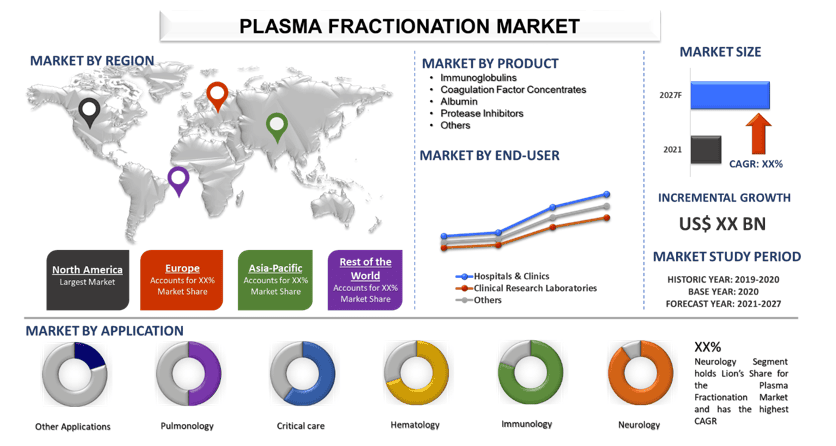
Plasma Fractionation Market is expected to exceed the market valuation of more than US$ ~43 billion in 2027 and is expected to grow at a significant CAGR of ~6% during the forecast period (2021-2027). Protein products fractionated from human plasma are an essential class of therapeutics used, often as the only available option, in the prevention, management, and treatment of life-threatening conditions resulting from trauma, congenital deficiencies, immunologic disorders, or infections. Modern plasma product production technology remains largely based on the ethanol fractionation process, but much has evolved in the last few years to improve product purity, to enhance the recovery of immunoglobulin G, and to isolate new plasma proteins, such as α1-protease inhibitor, von Willebrand factor, and protein C. Because of the human origin of the starting material and the pooling of 10,000 to 50,000 donations required for industrial processing, the major risk associated to plasma products is the transmission of blood-borne infectious agents. Most separation methods of blood plasma proteins are based on an initial altering of the physical and chemical properties of plasma or compounds within. This altering of properties leads to a change in solubility, and, ultimately, the precipitation of target plasma proteins within the liquid plasma solution. In some instances, the precipitation of plasma proteins is achieved through a controlled temperature change, known as cryoprecipitation. Most protein precipitation requires the addition of a precipitation or separation agent. Once the protein has precipitated, the protein can be isolated by mechanical or chemical separation methods.
The global Plasma Fractionation market is driven by the rapidly increasing global population. This has led to an intensification of the pressure on natural water resources. Consequently, consumers are shifting from natural water resources to the storage of water via various effective means, such as Plasma Fractionation, to keep the depletion of groundwater level under check. Moreover, due to the minimum maintenance, easy installation process, and availability in a wide range of tank sizes and types, Plasma Fractionation is becoming one of the most popular and adopted water harvesting mechanisms across the globe. Further, governments of several countries are promoting campaigns and initiatives to encourage the adoption of Plasma Fractionation in both domestic as well as industrial sectors. They are also offering tax relaxations and incentives to encourage the use of these systems; for example, the Government of India’s investments into the construction of numerous Plasma Fractionation structures in the rural and urban areas of the country, which is expected to assist in an equal distribution of and accessibility to drinking water. Decreasing fresh water is expected to accelerate the industry in the forecast period.
Global volume of blood plasma for fractionation (in million liters), 1990 to 2018

Baxter International Inc., Bio product laboratory, Biotest AG, CSL Ltd., Grifols SA, Kedrion S.P.A (Kedrion Biopharma Inc.), LFB S. A., Octapharma AG, Sanquin Blood Supply Foundation, and Takeda Pharmaceutical Company Limited are some of the prominent players operating in the Plasma Fractionation market. Several M&As along with partnerships have been undertaken by these players to facilitate customers with hi-tech and innovative products/technologies.
Insights Presented in the Report
“Amongst Product, Immunoglobulins segment holds the major share”
Based on Product, the Plasma Fractionation Market is segmented into Immunoglobulins, Coagulation Factor Concentrates, Albumin, Protease Inhibitors, and Others. Plasma-derived immunoglobulins are giving a new narrative to healthcare across a wide range of autoimmune inflammatory diseases. Clinically relevant antibody specific immunoglobulins include anti-D (anti-Rho), and antiHAV, anti-HBs, anti-tetanus, anti-varicella/herpes zoster and anti-rabies immunoglobulins.
“Amongst Application, Neurology segment holds the major share”
Based on Application, the Plasma Fractionation Market is segmented into Neurology, Immunology, Hematology, Critical care, Pulmonology, and Others. The largest share of this segment is mainly attributed to the surging neurological disorders that require plasma fractionation products and increasing research studies on plasma-derived products for neurological diseases. Additionally, the response of IVIg in a shorter period than steroids or oral immunosuppressants and its effectiveness in a number of disorders of the peripheral and central nervous systems is also a driving factor.
“North America represents one of the largest markets of Plasma Fractionation market”
For a better understanding of the market dynamics of the Plasma Fractionation market, a detailed analysis was conducted for different regions across the world including North America (US, Canada, Rest of North America), Europe (Germany, UK, France, Spain, Italy, Rest of Europe), Asia-Pacific (China, Japan, India, Australia, Rest of Asia-Pacific), Rest of World. North America dominated the market and grabbed around XX% market share owing to increasing chronic diseases and geriatric population.
Reasons to buy this report:
- The study includes market sizing and forecasting analysis validated by authenticated key industry experts
- The report presents a quick review of overall industry performance at one glance
- The report covers an in-depth analysis of prominent industry peers with a primary focus on key business financials, product portfolio, expansion strategies, and recent developments
- Detailed examination of drivers, restraints, key trends, and opportunities prevailing in the industry
- The study comprehensively covers the market across different segments
- Deep dive regional level analysis of the industry
Customization Options:
Plasma Fractionation market can further be customized as per the requirement or any other market segment. Besides this, UMI understands that you may have your own business needs, hence feel free to connect with us to get a report that completely suits your requirements.
Table of Content
Analyzing the historical market, estimation of the current market, and forecasting the future market of the Plasma Fractionation market were the three major steps undertaken to create and analyze the adoption of Plasma Fractionation in major regions globally. Exhaustive secondary research was conducted to collect the historical market numbers and estimate the current market size. Secondly, to validate these insights, numerous findings and assumptions were taken into consideration. Moreover, exhaustive primary interviews were also conducted, with industry experts across the value chain of the Plasma Fractionation market. Post assumption and validation of market numbers through primary interviews, we employed a top-down/bottom-up approach to forecasting the complete market size. Thereafter, market breakdown and data triangulation methods were adopted to estimate and analyze the market size of segments and sub-segments the industry pertains to. Detailed methodology is explained below:
Seek More Details About Research Methodology
Analysis of Historical Market Size
Step 1: In-Depth Study of Secondary Sources:
Detail secondary study was conducted to obtain the historical market size of the Plasma Fractionation through company internal sources such as annual report & financial statements, performance presentations, press releases, etc., and external sources including journals, news & articles, government publications, competitor publications, sector reports, third-party database, and other credible publications.
Step 2: Market Segmentation:
After obtaining the historical market size of the Plasma Fractionation market, we conducted a detailed secondary analysis to gather historical market insights and share for different segments & sub-segments for major regions. Major segments included in the report as Product, Application, and End-User. Further country-level analyses were conducted to evaluate the overall adoption of Plasma Fractionation in that region.
Step 3: Factor Analysis:
After acquiring the historical market size of different segments and sub-segments, we conducted a detailed factor analysis to estimate the current market size of Plasma Fractionation. Further, we conducted factor analysis using dependent and independent variables such as increasing chronic diseases and geriatric population. A thorough analysis was conducted for demand and supply-side scenarios considering top partnerships, merger and acquisition, business expansion, and product launches in the Plasma Fractionation sector across the globe.
Current Market Size Estimate & Forecast
Current Market Sizing: Based on actionable insights from the above 3 steps, we arrived at the current market size, key players in the Plasma Fractionation market, and market shares of the segments. All the required percentage shares split, and market breakdowns were determined using the above-mentioned secondary approach and were verified through primary interviews.
Estimation & Forecasting: For market estimation and forecast, weights were assigned to different factors including drivers & trends, restraints, and opportunities available for the stakeholders. After analyzing these factors, relevant forecasting techniques i.e., top-down/bottom-up approach was applied to arrive at the market forecast about 2027 for different segments and sub segments across the major markets globally. The research methodology adopted to estimate the market size encompasses:
- The industry’s market size, in terms of value (US$) and the adoption rate of Plasma Fractionation across the major markets domestically
- All percentage shares, splits, and breakdowns of market segments and sub-segments
- Key players in the Plasma Fractionation market in terms of products offered. Also, the growth strategies adopted by these players to compete in the fast-growing market
Market Size and Share Validation
Primary Research: In-depth interviews were conducted with the Key Opinion Leaders (KOLs) including Top Level Executives (CXO/VPs, Sales Head, Marketing Head, Operational Head, and Regional Head, Country Head, etc.) across major regions. Primary research findings were then summarized, and statistical analysis was performed to prove the stated hypothesis. Inputs from primary research were consolidated with secondary findings, hence turning information into actionable insights.
Split of Primary Participants in Different Regions

Market Engineering
Data triangulation technique was employed to complete the overall market estimation and to arrive at precise statistical numbers of each segment and sub-segment of the Plasma Fractionation market. Data was split into several segments & sub-segments post studying various parameters and trends in the areas of type and their type of the Plasma Fractionation market.
The main objective of the Plasma Fractionation Market Study
The current & future market trends of Plasma Fractionation were pinpointed in the study. Investors can gain strategic insights to base their discretion for investments from the qualitative and quantitative analysis performed in the study. Current and future market trends were determined the overall attractiveness of the market at a regional level, providing a platform for the industrial participant to exploit the untapped market to benefit as a first-mover advantage. Other quantitative goals of the studies include:
- Analyze the current and forecast market size of Plasma Fractionation in terms of value (US$). Also, analyze the current and forecast market size of different segments and sub-segments
- Segments in the study include areas of type and their subtypes
- Define and analysis of the regulatory framework for the Plasma Fractionation industry
- Analyze the value chain involved with the presence of various intermediaries, along with analyzing customer and competitor behaviors of the industry
- Analyze the current and forecast market size of the Plasma Fractionation market for the major region
- Major regions studied in the report include North America (US, Canada, Rest of North America), Europe (Germany, UK, France, Spain, Italy, Rest of Europe), Asia-Pacific (China, Japan, India, Australia, Rest of Asia-Pacific), Rest of World.
- Company profiles of the Plasma Fractionation market and the growth strategies adopted by the market players to sustain in the fast-growing market
Deep dive regional level analysis of the industry
Related Reports
Customers who bought this item also bought

